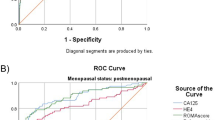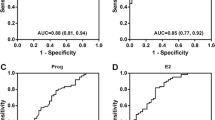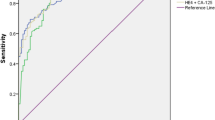Abstract
Purpose
To evaluate the diagnostic value of HE4 for distinguishing malignant pelvic masses from benign ones.
Methods
Eighty-five female patients diagnosed with pelvic masses and underwent elective surgery were enrolled. Preoperative serum samples for CA125, ROMA and HE4 were obtained, and the values were calculated. The diagnostic performances of HE4, CA-125 and ROMA, and best cutoff points were evaluated by using receiver operating characteristics curves and calculating sensitivity, specificity and area under curve (AUC).
Results
Among 85 women (47 premenopausal and 38 postmenopausal), 23 patients were diagnose with malignant pelvic masses while 62 were with benign. Significant diagnostic performance in discriminating malignant masses from benign ones and best cutoff points for CA125: premenopause, specificity 92.3 %, sensitivity 100 %, AUC ≥0.981, best cutoff >95.5, postmenopause, specificity 82.6 %, sensitivity 100 %, AUC ≥0.941, best cutoff point >58.15; for ROMA: postmenopause, specificity 73.9 %, sensitivity 100 %, AUC ≥0.904, best cutoff point >28.91. There was no significant value of HE4 alone in differentiation of pre–post menopausal benign and malignant groups (p = 0.910, p = 0.347).
Conclusions
HE4 may have more diagnostic value when used in combination with other biomarkers in differential diagnosis of malignant pelvic masses.


Similar content being viewed by others
References
Ferlay J, Soerjomataram I, Dikshit R, Eser S, Mathers C, Rebelo M, et al. Cancer incidence and mortality worldwide: sources, methods and major patterns in GLOBOCAN 2012. Int J Cancer. 2015;136:359–86.
Yang Z, Luo Z, Zhao B, Zhang W, Zhang J, Li Z, et al. Diagnosis and preoperative predictive value of serum HE4 concentrations for optimal debulking in epithelial ovarian cancer. Oncol Lett. 2013;6:28–34.
Kristjansdottir B, Levan K, Partheen K, Sundfeldt K. Diagnostic performance of the biomarkers HE4 and CA125 in type I and type II epithelial ovarian cancer. Gynecol Oncol. 2013;131:52–8.
Jacobs I, Oram D, Fairbanks J, Turner J, Frost C, Grudzinskas JG. A risk of malignancy index incorporating CA 125, ultrasound and menopausal status for the accurate preoperative diagnosis of ovarian cancer. Br J Obstet Gynaecol. 1990;97:922–9.
Moore RG, McMeekin DS, Brown AK, DiSilvestro P, Miller MC, Allard WJ, et al. A novel multiple marker bioassay utilizing HE4 and CA125 for the prediction of ovarian cancer in patients with a pelvic mass. Gynecol Oncol. 2009;112:40–6.
Abraham J. OVA1 test for preoperative assessment of ovarian cancer. Community Oncol. 2010;27:249–51.
Nunes N, Yazbek J, Ambler G, Hoo W, Naftalin J, Jurkovic D. Prospective evaluation of the IOTA logistic regression model LR2 for the diagnosis of ovarian cancer. Ultrasound Obstet Gynecol. 2012;40:355–9.
Yanaranop M, Tiyayon J, Siricharoenthai S, Nakrangsee S, Thinkhamrop B. Rajavithi-ovarian cancer predictive score (R-OPS): a new scoring system for predicting ovarian malignancy in women presenting with a pelvic mass. Gynecol Oncol. 2016;141:479–84.
Zhang P, Wang C, Cheng L, Zhang P, Guo L, Liu W, et al. Development of a multi-marker model combining HE4, CA125, progesterone, and estradiol for distinguishing benign from malignant pelvic masses in postmenopausal women. Tumour Biol. 2016;37:2183–91.
Moore RG, Jabre-Raughley M, Brown AK, Robison KM, Miller MC, Allard WJ, et al. Comparison of a novel multiple marker assay vs the Risk of Malignancy Index for the prediction of epithelial ovarian cancer in patients with a pelvic mass. Am J Obstet Gynecol. 2010;203:228.e1–6.
Karlsen MA, Sandhu N, Høgdall C, Christensen IJ, Nedergaard L, Lundvall L, et al. Evaluation of HE4, CA125, risk of ovarian malignancy algorithm (ROMA) and risk of malignancy index (RMI) as diagnostic tools of epithelial ovarian cancer in patients with a pelvic mass. Gynecol Oncol. 2012;127:379–83.
Montagnana M, Danese E, Ruzzenente O, Bresciani V, Nuzzo T, Gelati M, et al. The ROMA (Risk of Ovarian Malignancy Algorithm) for estimating the risk of epithelial ovarian cancer in women presenting with pelvic mass: is it really useful? Clin Chem Lab Med. 2011;49:521–5.
Jacob F, Meier M, Caduff R, Goldstein D, Pochechueva T, Hacker N, et al. No benefit from combining HE4 and CA125 as ovarian tumor markers in a clinical setting. Gynecol Oncol. 2011;121:487–91.
Lu R, Sun X, Xiao R, Zhou L, Gao X, Guo L. Human epididymis protein 4 (HE4) plays a key role in ovarian cancer cell adhesion and motility. Biochem Biophys Res Commun. 2012;419:274–80.
Granato T, Porpora MG, Longo F, Angeloni A, Manganaro L, Anastasi E. HE4 in the differential diagnosis of ovarian masses. Clin Chim Acta. 2015;446:147–55.
Holcomb K, Vucetic Z, Miller MC, Knapp RC. Human epididymis protein 4 offers superior specificity in the differentiation of benign and malignant adnexal masses in premenopausal women. Am J Obstet Gynecol. 2011;205:358.e1–6.
Moore RG, Brown AK, Miller MC, Skates S, Allard WJ, Verch T, et al. The use of multiple novel tumor biomarkers for the detection of ovarian carcinoma in patients with a pelvic mass. Gynecol Oncol. 2008;108:402–8.
Anastasi E, Marchei GG, Viggiani V, Gennarini G, Frati L, Reale MG. HE4: a new potential early biomarker for the recurrence of ovarian cancer. Tumour Biol. 2010;31:113–9.
Terry KL, Schock H, Fortner RT, Hüsing A, Fichorova RN, Yamamoto HS, et al. A prospective evaluation of early detection biomarkers for ovarian cancer in the European EPIC cohort. Clin Cancer Res. 2016. doi:10.1158/1078-0432.CCR-16-0316
Zhang Y, Qiao C, Li L, Zhao X, Li Y. Serum HE4 is more suitable as a biomarker than CA125 in Chinese women with benign gynecologic disorders. Afr Health Sci. 2014;14(4):913–8.
Zhang Q, Wang CR, Yu JP, Ma Q, Xu WW. The establishment of an HE4-CLIA method and the combined analysis of HE4 and CA125 in ovarian cancer. J Clin Lab Anal. 2016. doi:10.1002/jcla.21926.
Fawzy A, Mohamed MR, Ali MA, Abd MA, El-Magied MH, Helal AM. Tissue CA125 and HE4 gene expression levels offer superior accuracy in discriminating benign from malignant pelvic masses. Asian Pac J Cancer Prev. 2016;17:323–33.
Chen X, Zhou H, Chen R, He J, Wang Y, Huang L, et al. Development of a multimarker assay for differential diagnosis of benign and malignant pelvic masses. Clin Chim Acta. 2015;440:57–63.
Romagnolo C, Leon AE, Fabricio AS, Taborelli M, Polesel J, Del Pup L, et al. HE4, CA125 and risk of ovarian malignancy algorithm (ROMA) as diagnostic tools for ovarian cancer in patients with a pelvic mass: an Italian multicenter study. Gynecol Oncol. 2016;141:303–11.
Presl J, Kučera R, Topolčan O, Novotný Z, Vrzalová J, Fuchsova R, et al. HE4 a biomarker of ovarian cancer. Ceska Gynekol. 2012;77:445–9.
Angioli R, Plotti F, Capriglione S, Montera R, Damiani P, Ricciardi R, et al. The role of novel biomarker HE4 in endometrial cancer: a case control prospective study. Tumour Biol. 2013;34:571–6.
Schummer M, Drescher C, Forrest R, Gough S, Thorpe J, Hellström I, et al. Evaluation of ovarian cancer remission markers HE4, MMP7 and Mesothelin by comparison to the established marker CA125. Gynecol Oncol. 2012;125:65–9.
Plotti F, Capriglione S, Terranova C, Montera R, Aloisi A, Damiani P, et al. Does HE4 have a role as biomarker in the recurrence of ovarian cancer? Tumour Biol. 2012;33:2117–23.
Jiang J, Bo D, Chang X, Cheng H, Ye X, Cui H. Discrepant clinicopathologic characteristics and HE4 performance in type I and type II epithelial ovarian cancer. Int J Clin Exp Med. 2015;8:21303–10.
Wilailak S, Chan KK, Chen CA, Nam JH, Ochiai K, Aw TC, et al. Distinguishing benign from malignant pelvic mass utilizing an algorithm with HE4, menopausal status, and ultrasound findings. J Gynecol Oncol. 2015;26:46–53.
Author information
Authors and Affiliations
Corresponding author
Ethics declarations
Conflict of interest
The authors declare that there are no conflicts of interest.
Rights and permissions
About this article
Cite this article
Onal, M., Malatyalioglu, E., Kurtoglu Ozdes, E. et al. Diagnostic Value of HE4 in Distinguishing Malignant from Benign Pelvic Masses. Indian J Gynecol Oncolog 14, 51 (2016). https://doi.org/10.1007/s40944-016-0079-8
Received:
Revised:
Accepted:
Published:
DOI: https://doi.org/10.1007/s40944-016-0079-8




